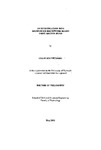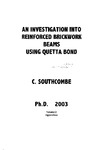AN INVESTIGATION INTO REINFORCED BRICKWORK BEAMS USING QUETTA BOND
| dc.contributor.author | SOUTHCOMBE, COLlN | |
| dc.contributor.other | Faculty of Science and Engineering | en_US |
| dc.date.accessioned | 2013-10-22T11:42:01Z | |
| dc.date.available | 2013-10-22T11:42:01Z | |
| dc.date.issued | 2003 | |
| dc.identifier | NOT AVAILABLE | en_US |
| dc.identifier.uri | http://hdl.handle.net/10026.1/2289 | |
| dc.description.abstract |
This study considered the design, development and testing of a new type of reinforced grouted cavity clay brickwork beam, the University of Plymouth Quetta Style Beam (the "Beam"). Under experimental load, the beam format results in asymmetric, non-linear, elastic bending and shear stress contours. This is contrary to beam behaviour acknowledged, in the codes, for reinforced brickwork and other structural materials. A suggested hypothesis is "evidence has been produced of excessive tensile stress beyond the steel yield stress, which may or may not be due to brick tensile strength". This hypothesis is based on a relatively small sample and upon the determination of the neutral axis depth which depends on the shape of the compressive stress diagram. It is suggested that this hypothesis is worthy of further experimental investigation and analysis. The Beam has enhanced flexural strength when compared with beams reinforced in the bed joints and with some grouted cavity reinforced brickwork beams, studied so far. Tests on and analysis of brickwork prisms showed that the Structural Code for Reinforced Masonry, BS 5628-2- 2000, recommends extremely conservative design strengths, particularly when perforated bricks are used. It is further suggested the Code does not fully recognize the potential strength of brickwork. In this study 54 beams were built; reinforced and unreinforced in shear. Every beam was replicated three times and three brick types and three different spans were used. An important aspect of the Beam is the bonding of the outer leaves of brickwork with the grouted core. Bricks in the compression zone were loaded in their weaker directions. Vertical pockets of grout, incorporated into the Beam design, allow easy provision of shear links. The bonding format and integrated system is not detrimental to the flexural resistance of the Beam but produces a compressive stress diagram, at ultimate load, which does not conform to the parabolic curve used in reinforced concrete and in symmetrically reinforced brickwork beams. This is perhaps a more realistic model for reinforced clay brickwork. Beams were analysed using elastic and limit states theories. A 30 Finite Element Analysis (FEA) showed, possibly for the first time, the complex, asymmetric, non-linear, elastic stress contours which develop in non-traditionally bonded brickwork. Equations are proposed in this study which would enable the depth of the Beam to be selected to resist an applied bending moment and also, if confirmed by further studies, a method to incorporate the excess tensile force into the analysis of the section capacities and to ascertain the neutral axis depth. The Beam was used on five construction sites on and off campus. These performed well. It was identified that: the characteristic compressive strength of non-traditionally bonded brickwork should be obtained by the use of prism tests, when an accurate economical design is required; significant loss of the potential characteristic strength of perforated and solid clay brickwork is due to the use of a bonding material whose basic strength is less than the compressive strength of the brick. A study is needed to identify an improved bonding material for an structural brickwork. | en_US |
| dc.language.iso | en | en_US |
| dc.publisher | University of Plymouth | en_US |
| dc.title | AN INVESTIGATION INTO REINFORCED BRICKWORK BEAMS USING QUETTA BOND | en_US |
| dc.type | Thesis | |
| dc.identifier.doi | http://dx.doi.org/10.24382/3300 |
Files in this item
This item appears in the following Collection(s)
-
01 Research Theses Main Collection
Research Theses Main



